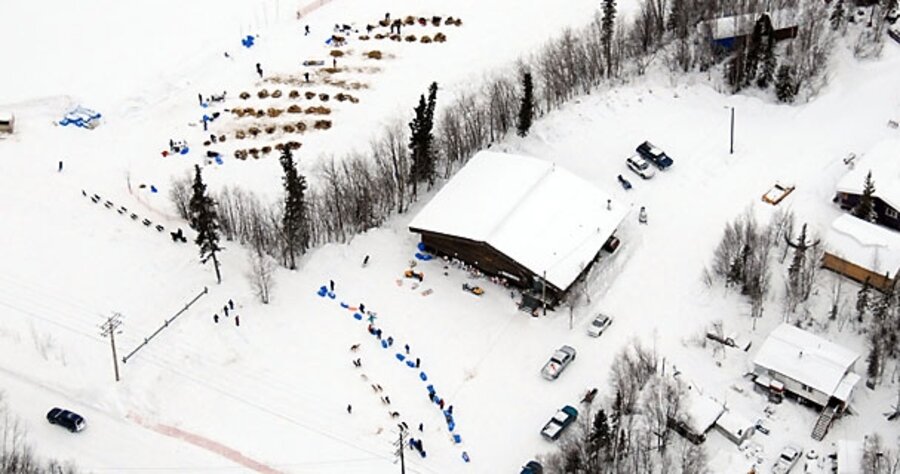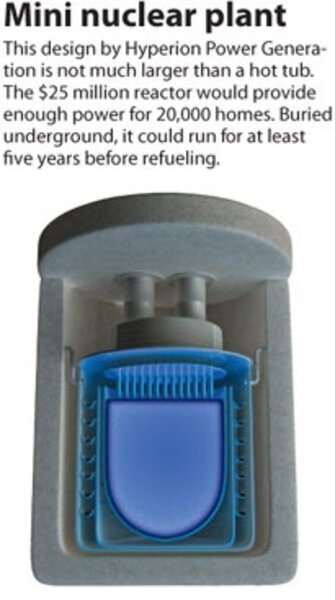Backyard reactors? Firms shrink the nukes.
Loading...
Hundreds of miles from the nearest power plant, the roughly 700 residents of Galena, Alaska, depend on costly generator-supplied electricity for their homes.
But now, they want to go nuclear.
No, not a traditional hulking nuclear power plant. That would be far too big. Instead, town leaders have signed up for what some call a “pocket nuke” or “nuclear battery” that produces just 10 megawatts – about 1 percent of the energy an average nuclear plant generates.
Japanese manufacturer Toshiba has told the town it will install its new “4S” (Super-safe, small, and simple) reactor free of charge by 2012.
The unit, which would be buried about 100 feet underground, would only have to be refueled every 30 years or so. A turbine station would sit above the reactor, turning heat from the reactor into electricity.
Interest in pocket nuclear plants is growing among developing countries and island nations, advocates say. Like solar and wind power, a pocket nuke is a modular, carbon-free power source. Unlike those other energy sources, it would generate power 24/7 and at a fraction of the cost of a diesel generator, they say.
At least two other companies – Hyperion Power Generation of Sante Fe, N.M., and NuScale Power of Corvallis, Ore. – are also planning mini nuclear power plants. Hyperion says its $25 million “hot tub”-size reactor could be transported by ship, rail, or truck.
“We started getting calls from islands around the planet,” says Deborah Blackwell, vice president of licensing and public affairs for Hyperion.
“We do have a nice little list of people hoping to get signed agreements with us. We have some [US customers] that are pending.”
The 25-megawatt reactor Hyperion wants to build would be buried underground and could power about 20,000 homes. Modular units could be
added as demand grew. According to the company, its mini-reactor would be almost entirely self-regulating, designed to shut down instantly if a problem arose, and last for five to seven years before the fuel would need to be replaced. The unit would then be dug up and taken to the factory. Fuel would be low-enriched uranium hydride – not weapons-grade fuel.
Still, the idea of thousands of pocket-nuclear plants scattered worldwide worries nuclear nonproliferation and safety experts.
“Any nuclear reactor fueled by uranium makes plutonium as an unavoidable byproduct,” says Gordon Thompson, a physicist and executive director of the Institute for Resource and Security Studies, a think tank in Cambridge, Mass. “We know that any plutonium of any isotopic composition can be used to make nuclear weapons – and a reactor can be modified to increase production of plutonium.”
By putting such devices in large numbers in many countries, you actually “increase the risk of failure” across a diversity of locations, Mr. Thompson says.
Others, however, say sabotage – turning mini nuclear plants into radiological weapons – is a critical problem.
“Even a small 20-megawatt reactor, if sabotaged, can release a substantial amount of radiation,” says Edwin Lyman, a nuclear-security expert with the Union of Concerned Scientists. “So you’re going to need a costly security force pretty much the same as at a large reactor.”
Safety and security won’t be a problem, say Hyperion executives.
“There’s a lot of easier ways to get uranium than from one of these,” Ms. Blackwell says. “It would still be normal to have security. But it’s mainly to make the population feel better. It’s not that it’s really needed.”
For its part, NuScale says its design is based on proven commercial light-water reactor technology. Nevertheless, the company sees its units built in a far more controlled setting with significant security arrangements.
“We do not view these [mini nuclear] systems as appropriate for distributed generation,” says Bruce Landrey, director of marketing for NuScale. “Our plants will be sited and built similar to other nuclear power plants” and “under the requirements of the International Atomic Energy Agency.”
Before any pocket nuke hits the market, however, they must pass safety reviews with the Nuclear Regulatory Commission (NRC) – a high hurdle – and surmount any opposition from environmental and antinuclear groups.
For now, Toshiba is on track to apply for a formal NRC review of its 4S reactor design in late 2009, a commission spokesman says.






